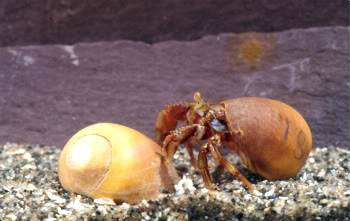|
|
Research from Queen’s University Belfast has raised new issues about the culinary arts. Long-thought by cooks and diners to be insensible to pain, a new study published in the journal Animal Behavior shows that crabs not only feel pain but remember it well-enough after the sensation has passed to affect their future decisions. According to Dr. Bob Elwood, who headed up the research, the study should bring about changes in how crustaceans like crabs are treated by the fishing and food industries.
To determine if crustaceans felt pain, Elwood attached wires to particular shells that would deliver small shocks to the hermit crabs inside the shell. Since hermit crabs do not have an attached shell like many crustaceans—using empty mollusc shells for protection—they are therefore able to abandon the shell at will.
 Test-subject hermit crab. Photo by Bob Elwood. |
The hermit crabs which were shocked were the only ones to abandon their shells, showing that the shock was painful enough for them to leave their protective home.
“There has been a long debate about whether crustaceans including crabs, prawns and lobsters feel pain,” Elwood said. “We know from previous research that they can detect harmful stimuli and withdraw from the source of the stimuli but that could be a simple reflex without the inner ‘feeling’ of unpleasantness that we associate with pain. This research demonstrates that it is not a simple reflex but that crabs trade-off their need for a quality shell with the need to avoid the harmful stimulus”.
Pushing the experiment further, Elwood tested at what level the shock would be small enough so that the crab would remain in the shell. At this point a new shell was offered to the crab. The hermit crabs that were shocked, even at a very low level, were more likely to move out of their shell and examine the new shell. They were also more likely to change their old shell—which had given them the shock—for the new one. Their reactions showed that not only are hermit crabs experiencing pain but they are remembering it well-enough to trade the first shell, which was a perfectly fine shell in every other way, for another, sometimes lesser, shell.
Elwood says that this trading of one shell for another is not dissimilar from how humans respond to pain. “Such trade-offs are seen in vertebrates in which the response to pain is controlled with respect to other requirements. Humans, for example, may hold on a hot plate that contains food whereas they may drop an empty plate, showing that we take into account differing motivational requirements when responding to pain. Trade-offs of this type have not been previously demonstrated in crustaceans.”
Prior to this, Elwood has conducted research that showed prawns feel pain as well. However, Elwood points out that such research has not made its way to the fishing and food industries.
“More research is needed in this area where a potentially very large problem is being ignored…Millions of crustacean are caught or reared in aquaculture for the food industry. There is no protection for these animals (with the possible exception of certain states in Australia) as the presumption is that they cannot experience pain. With vertebrates we are asked to err on the side of caution and I believe this is the approach to take with these crustaceans.”
Related articles
Dedicated rock-throwing chimp proves longterm planning
(03/10/2009)
Biologists have suspected for a long time that animals other than humans are capable of making plans for future events, but it has proven difficult to show conclusively. However, a new study in Current Biology claims the first unambiguous evidence of an animal premeditating. Mathias Osvath of Lund University in Sweden has spent a decade observing a male chimpanzee in a zoo collecting stones, making them into concrete discs, and then throwing them at zoo visitors.
Butterfly tricks ants by mimicking their queen’s vocalizations
(02/05/2009)
With cohesive hierarchical societies and a number of communication techniques, ants have been able to conquer a wide variety of ecosystems with great success. However, according to a recent paper in Science ants’ highly structured society at times comes with a price. A number of insects have evolved means to covertly infiltrate the ants’ society and live off their work and bounty by closely mimicking various ant communication methods. While scientists believe that these parasitical insects largely mimic ant communications like chemical exchange and physical contact—such as touching antennae—the study, however, discovered a butterfly which succeeds in infiltrating the highest echelons of ant society by vocalizing like a queen.
The honeybee can count
(01/29/2009)
Plato once said: “numbers are the highest degree of knowledge: it is knowledge itself.” By Plato’s standards researchers have just discovered that the honey bee is a knowledgeable insect indeed. The honey bee can count to three in an instant according to a new study in the online journal PLoS ONE. Using dots and other abstract symbols, scientists from the Vision Centre in Australia tested whether the honey bees had the ability to count items in their environment.
Insect intelligence: paper wasps display strong long-term memory
(12/01/2008)
A recent study in Current Biology finds that paper wasps are capable of remembering rivals a week after initially meeting. As a highly social insect, the discovery proves that the paper wasps’ social interactions are based on applied memory rather than simple instinct. The finding overturns many ideas about the intelligence of insects.
When the magpie looks in a mirror, it sees itself
(08/20/2008)
Unlike Narcissus of Greek mythology–who upon seeing his reflection in water jumped in thinking it was another–magpies have proven they can recognize their own reflections. Until now, only a small number of primates (chimpanzees, pygmy chimps, and orangutans) have displayed this ability, making the magpie the first bird shown to recognize itself.